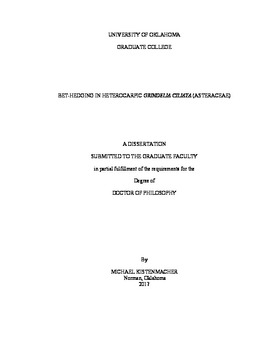| dc.description.abstract | A challenge for all living organisms is to offset the fitness associated risks of environmental uncertainty. Bet-hedging strategies are adaptive in unpredictable environments and are documented in a wide range of taxa spanning all kingdoms (Simons 2011, see Appendix A). There are two general types of bet-hedging strategies, a conservative strategy exemplified by the phrase "a jack of all trades and master of none" and the more common diversified strategy best described by the phrase "don't put all your eggs in one basket" (Seger and Brockman, 1987; Simons, 2011, see Appendix A). Although there are differences between them, both are based on the principle that mean geometric fitness increases by reducing fitness variation among years (Cohen, 1966; Gillespie, 1974; Philippi and Seger, 1989, see Appendix A).
In annual plants, small germination fractions and high seed survival in the seed bank are adaptive when good years occur unpredictably or in a low frequency. The opposite is true for environments when the probability of a good year is high. Mathematical models have derived these theoretical predictions (Cohen 1966; Levin et al. 1984; Venable and Brown, 1988; Venable and Lawlor 1980, see Appendix A), but empirical tests of these models remains problematic, primarily because documentation of changes in geometric mean fitness are not realized until different environmental conditions are experienced by the study organism. Since bet-hedging strategies are adapted on an evolutionary time scale, environmental conditions to hedge against may not be experienced in a human lifetime, or longer. Thus, field experiments are not optimal for testing bet-hedging theory. However a few long term observational studies support theoretical expectations (see Pake and Venable 1996; Venable, 2007, see Appendix A), and long-term manipulative experiments that alter environmental conditions (e.g. precipitation frequency) are feasible approaches (Petru and Tielboerger 2008, see Appendix A). Modeling is another method for testing theoretical predictions, specifically by combining demographic models that are coupled with environmental models that alter soil temperature and soil water content. Demographic models have been applied to estimate population growth rates in desert annuals by deriving parameters such as reproductive output, recruitment from the seed bank, and survivorship in response to simulated precipitation regimes (Gremer and Venable 2014; Salguero-Gomez et al. 2012, see Appendix A).
Bet-hedging literature consists of a mixture of results that support and reject theoretical predictions, particularly in regard to seed germination and dormancy. This is due, in part, to the inability to incorporate mechanisms such as phenotypic plasticity and maternal effects that confound observations of demographic traits (i.e., seed production and seed dormancy) in natural populations. Another shortcoming is that comparisons of demographic traits at the population level are not incorporated into predictive models, resulting in hampered understanding of underlying genetic differences in the expression of bet hedging strategies, which are important variables determining population persistence and range dynamics. Lastly, and potentially the greatest shortcoming, is that risk avoidance from alternative selection agents (i.e., herbivores) are almost entirely non-existent. For example, frequent pre and post dispersal seed predation (i.e., granivory) may favor adaptations that reduce the risk of predation, such as increased lignification, or accumulation of tannins and similar defense compounds in fruit or seed coats (i.e., pericarp, and testa), that simultaneously alter germination or dormancy. Since plant-animal interactions are ubiquitous, and because the selective pressure animals impose on plant fitness can be extremely strong, we cannot truly understand plant bet hedging strategies without accounting this selective force.
Chapter one is an explanation of why the Cox Proportional Hazard (CPH) model is an excellent choice for analyzing germination data. Historically, germination data was analyzed by analysis of variance, however the nature of germination data requires more complicated statistical analysis. The CPH is a suitable choice, but certain shortcomings in the standard CPH were identified (Ritz et al. 2013, see Appendix A). This chapter presents the use of the extended CPH (Kleinbaum and Klein 2012, see Appendix A), and demonstrates its ability to overcome the shortcomings of the standard CPH. The major strength of the extended CPH is the flexibility to statistically compare time intervals of interest to the user.
Chapter two presents an investigation into the variability in germination and dormancy among G. ciliata populations in Oklahoma. The germination trends that were observed in chapter one are explained in chapter two and it is shown that significant differences in dormancy exist among populations. Such variation may strongly affect how seedbank and population dynamics.
Chapter three is an investigation of how reproductive bet-hedging in an Oklahoma native forb Grindelia ciliata (Asteraceae), is affected by the seed herbivore Schinia mortua (Noctuidae). Female S. mortua moths determine the time, location, and abundance of S. mortua larvae that will consume the G. ciliata seeds. By manipulating location, timing, and abundance of larvae I evaluate the impact that this herbivore has on plant fitness. | en_US |
